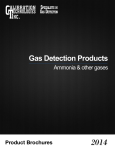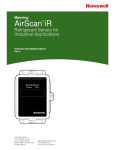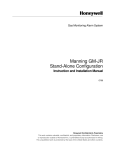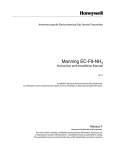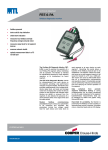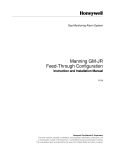Download User Manuals - Honeywell Analytics
Transcript
VL-F7-N4-LPA-MK Instruction and Installation Manual Vent Line Sensor for Ammonia and Other Refrigerants Linear 4/20 mA Output MOUNT ENCLOSURE THIS END UP. DO NOT BLOCK PERFORATED VENT HOLES. PRE-AMP ® 405 Barclay Boulevard Lincolnshire, Illinois 60069 Tel: +1 847 955 8200 Toll free: +1 800 538 0363 Fax: +1 847 955 8208 [email protected] Manning VL-F7-LPA Gas Sensor 18394 VLF7LPA 02/2005 REVF Copyright © 2005 Manning Systems, Inc. All Rights Reserved. 18394 VLF7LPA 01/2014 REV G 1 Contents Serial number: Section Title Page 1 Sensor Description 3 2 Installation 5 3 Operation 8 4 Limited Warranty 10 Special Caution Always assume that a relief valve can release at any moment. Always employ a “buddy” system, having help with you and watching what you are doing at all times. Always use safety goggles or a safety face shield, and always use gloves and have additional protective equipment easily available, including eye flushing equipment and a breathing apparatus. Personnel should be well trained and protected against falling if a sudden refrigerant leak startles the service person. Make sure there is always an escape route in case of a refrigerant release. Introduction This manual has been prepared to help in the use and installation of the Manning Systems VL-F7-LPA Vent Line Sensor. This manual will convey the operating details of the sensor, ensure proper installation, and demonstrate start-up and routine maintenance procedures. This manual must be carefully followed by all individuals who have or will have the responsibility for using or servicing the sensor. Warranties made by Manning Systems, Inc. with respect to this equipment will be voided if the equipment is not used and serviced in accordance with the instructions in this manual. If in doubt about a procedure, please contact Manning Systems, Inc. before proceeding. Manning VL-F7-LPA Gas Sensor 18394 VLF7LPA 02/2005 REVF Copyright © 2005 Manning Systems, Inc. All Rights Reserved. 2 1 Sensor Description The Manning Systems VL-F7-LPA Vent Line Sensor has a solid-state sensor imbedded in a 2" forged steel bull plug. A NEMA 4, 16 gauge steel box is fastened to the bull plug and houses a terminal strip. This is then wired to the current pre-amp which transmits a linear 4/20 mA signal to the readout equipment. Figure 1: Dimensions of the Vent Line Sensor and Pre-Amp 4 1/2" 2 3/8" The standard trip points are normally in the 5,000 ppm to 10,000 ppm range. Manning Systems highly recommends that trip points be in this range due to the fact that minute amounts of a refrigerant released in the very small volume of a relief header will cause very high gas concentrations, normally in the percent range. Trying to have lower setpoints almost always results in false trips. The solid-state sensor used in this design must be considered “broad-spectrum,” i.e., it will detect many gases. Normally this is not a problem due to the higher setpoints commonly used. 3 1/8" 2" N.P.T. pipe plug 7/8" diameter hole for 1/2" conduit electrical connection The VL-F7-LPA Vent Line Sensor should only be used in non-hazardous locations. Explosion-proof designs are not available at this time. The sensors normally exhibit long life (five to eight years) unless exposed to very high gas concentrations for long periods or immersed in liquid refrigerant. Proper location in mounting the vent line sensor is the key to long and trouble-free life. Carefully review the 5/16" diameter 2" MOUNT ENCLOSURE THIS END UP. DO NOT BLOCK PERFORATED VENT HOLES. mounting instruction portion of this manual. 6 3/4" PRE-AMP ® Manning VL-F7-LPA Gas Sensor 18394 VLF7LPA 02/2005 REVF Copyright © 2005 Manning Systems, Inc. All Rights Reserved. 3 1 Sensor Description continued System Specifications Method: Solid-state Range: • • Ammonia – 0 to 10,000 ppm (1%) CFC/HCFC/HFCs – 0 to 1,000 ppm (depending on refrigerant) Output: Linear 4/20 mA – connects to all Manning Systems readouts or other devices capable of accepting a 4/20 mA signal Power Requirements: Powered directly from Manning Systems readouts or, when used as 4/20 mA pre-amp and sensor only, requires 17/24 VDC at 200 mA Operating Temperatures: –20° F to +120° F Enclosures: • • Sensor – Aluminum NEMA 4 Pre-amp – Stainless Steel NEMA 4 Weight: • • 3 lbs., sensor only 15 lbs., with mounting kit Dimensions: • • Sensor – 4 1/2" x 3 1/8" x 3 1/8" 4/20 mA pre-amp enclosure – 6" x 4" x 4" Cable Requirements: • • Pre-amp to readout – #18/3 shielded cable (Belden #8770), maximum run length 1,500 feet Sensor to pre-amp – #16 AWG, 4 conductors, non-shielded for runs up to 25 feet Specifications subject to change without notice. Manning VL-F7-LPA Gas Sensor 18394 VLF7LPA 02/2005 REVF Copyright © 2005 Manning Systems, Inc. All Rights Reserved. 4 2 A Installation Locating the VL-F7-LPA in a Vent Line System Discharging to atmosphere, vent line sensors must be mounted within one or two feet from discharge into the air. Over 95% of all problems experienced with the VL Vent Line Sensor have been due to mounting the sensor away from the discharge, usually lower into the system, below the roof line. In this lower area you will encounter residual oil from previous releases, bacterial action due to moisture and heat, pipe coating residuals and minute relief valve weeping. All this action is additive and is a sure cause for trouble. See Figure 2 which shows where to mount the vent line sensor. Important mounting considerations: • Make sure discharge does not come down on top of sensor, i.e., hit the sensor or maintenance personnel when working on sensor. • Weld nipple to a vertical pipe. • Do provide a plug or means of inducing a draft through the vent header to remove residual refrigerant after a leak. (Check with local codes to see what is allowed in your area before doing this.) Inducing an easy means of clearing the header will help in troubleshooting a weeping relief valve. • Safety – Always follow accepted industry practice by using a face shield and gloves when working on the vent line sensor or any part of the vent line system. Always assume a relief valve could release at any moment. Always treat vent line systems with extreme caution (see Figure 2). B Mounting the VL-F7-LPA in a Relief System Venting Directly into a Water Tank Due to numerous code requirements a common practice is to plumb vent line systems to discharge directly into a water tank. Even though this seems like a very simple and safe way to protect from atmospheric discharge, it presents some unique challenges to the refrigeration designer in assuring a safe relief system. It also presents challenges in where to mount the vent line sensor. The vent line sensor was developed over the years for monitoring atmospheric discharge of vent lines. When properly mounted as described in Section A, it is an extremely reliable method of detecting releases to the atmosphere. Figure 2: Mounting the Vent Line Sensor IMPORTANT: The vent line sensor must be mounted no further than 1 to 2 feet from discharge Nipple Tee Make sure discharge does not hit the vent line sensor housing Vent line header NEMA 4 design (keep away from discharge) 2" plug 3/4" plug for testing Roof line Manning VL-F7-LPA Gas Sensor 18394 VLF7LPA 02/2005 REVF Copyright © 2005 Manning Systems, Inc. All Rights Reserved. 25' max between sensor and pre-amp Mount pre-amp for easy access 5 2 Installation continued The advent of the water dump tank utilizing a standard water level covering the relief header discharge presents the vent line sensor with some unique challenges. There are several possible mounting locations as follows: • Water tank atmospheric vent. The simplest and most trouble-free method of mounting a vent line sensor is in this location. This location will not catch the small weepers but only the larger discharges resulting in NH3 vapor escaping from the water tank. This method requires no compressed air venting and the resulting problems this can cause. To help eliminate water condensation on the sensor, remove the 3/4" test plug to allow ventilation across the sensor (see Figure 3). • Mounting the sensor between the water seal and relief valves. After years of actual field experience this location has proven the most difficult. There have been occasions where the water has been siphoned back into the vent header, completely immersing the vent line sensor and relief valves. Figure 3: Mounting the Vent Line Sensor when using a water tank atmospheric vent • Mounted with compressed air purge. The most successful systems have used compressed air venting into the header as shown in Figure 4. It is essential that this is dry air. Small compressors dedicated to this have been marginally effective due to the water condensed during the compression cycle. It is essential the compressed air be dry in order to help purge the complete vent line header and also to compensate for the moisture migration from the water seal. Process facilities that have plant compressed air work the best when utilizing a large dedicated dryer for the air injection. The purge air will cause a small pressure to build due to the water “head” of the tank. A water head of 15 feet to 20 feet will cause the sensor to be 30 to 40 percent less sensitive due to the higher air pressure. This is normally not a problem due to the high refrigerant concentrations needed for a trip condition (see Figure 4). In summary, if at all possible mount the vent line sensor on the tank atmospheric vent and utilize a water monitoring method such as pH in the water tank. Figure 4: Compressed air purge system for the Vent Line Sensor Suggest removing 3/4" plug to allow ventilation across sensor to minimize water condensation 1 to 5 liters per minute Relief header Flow meter Regulator Compressed air supply Check valve Water level Needle valve Filter Relief header Tie in at lowest point Water purge tank Manning VL-F7-LPA Gas Sensor 18394 VLF7LPA 02/2005 REVF Copyright © 2005 Manning Systems, Inc. All Rights Reserved. 6 2 C Installation continued Wiring conduit and dripping into the sensor enclosure. Silicone should not be used near the sensor, because silicone can damage the sensor. Figure 5 presents wiring information for the VL-F7-LPA. Electrical wiring must comply with all applicable codes. Plant equipment that may be involved and operating conditions should be discussed with local operating personnel to determine if any special needs should be taken into account. Make drip loops for cables going into sensor housings. Follow the mounting instructions on the Pre-Amp enclosure (…This End Up). See Figure 2. Electrical Power: 24 VDC regulated, 300 mA. Nearly all start-up problems are due to improper wiring or monitor configuration. Please follow these guidelines carefully. Output: Linear 4/20 mA output corresponding to 0–1%. Monitoring equipment may have a maximum input impedance of 250 ohms. Between the current pre-amp and monitoring equipment use three conductor, #18 AWG, insulated, stranded, shielded copper cable. Between the vent line sensor and current pre-amp use #16 AWG, four conductors, nonshielded. Do not pull sensor wiring with AC power cables. This will cause electrical interference. Be sure there are no breaks or splices in sensor wiring runs. If cable runs cannot be made without a splice, all connections must be soldered. Soldering should be done using a rosin flux to tie the connecting ends of sensor wires to ensure a positive and long-lasting contact. Cable Recommendation, Pre-Amp to Monitoring Device: #18/3 shielded cable (Belden #8770 or equivalent). Length of cable to pre-amp should be no greater than 1,500 feet. Use only the existing punched holes for connections to the pre-amp. Cable Recommendation, Vent Line Sensor to Pre-Amp: #16 AWG, 4 conductors non-shielded. Length of cable from vent line sensor to pre-amp should be no greater than 25 feet. Use only the existing punched holes for connections to the pre-amp. Ground the shield at the main control panel. Tape all exposed shield wire at the sensor to insulate it from the enclosure. Monitoring: The VL-F7-LPA Sensor may be monitored by the Manning Systems GM-10, GM-4, GM-1, GM-JR or other appropriately configured system. Monitoring equipment must be configured to indicate a fault if the signal is below 1.5 mA. All penetrations into a refrigerated room should be sealed to prevent condensate from forming in the A signal above 20 mA must be considered a high gas concentration. Figure 5: Wiring diagram for the Vent Line Sensor Linear Pre-Amp Gas sensor TEST + 1500' maximum— 3-conductor #18 AWG shielded (Belden #8770 or equivalent) 40 TO 200 MVDC + CAL + – – 12 TO 24 VDC 4 - 20 mA R R O O +24 SIG SHD TEST – GND Bare— Connects to case ground of monitoring equipment (earth ground) Junction box may be rotated 1/2 turn either direction relative to pipe plug to align conduit hole as required to facilitate electrical connection CAL FLT Black— Connects to power supply ground side VL sensor junction box cover S ZERO SPAN White— Connects to signal input of monitoring equipment Red— Connects to 24 VDC power supply positive side (300 mA) VL sensor MANNING SYSTEMS, INC. MSI LSS 400 REV 0 GND 2" N.P.T. pipe plug 7/8" Diameter hole for 1/2" conduit electrical connection. Conduit hole should always be mounted pointing down RED RED ORANGE ORANGE Manning VL-F7-LPA Gas Sensor 18394 VLF7LPA 02/2005 REVF Copyright © 2005 Manning Systems, Inc. All Rights Reserved. (cover removed) R R O O Existing sensor wires O-Ring seal gasket for CEMA/NEMA 4 applications 25' maximum— 16 AWG, 4 conductors, non-shielded 7 3 A Operation Start-Up Procedures Before applying power, make a final check of all wiring for continuity, shorts, grounds, etc. It is usually best to disconnect external alarms and other equipment from the sensor until the initial start-up procedures are completed. After power-up, allow 24 hours for the system to stabilize before testing the sensors. Because sensors are normally located at a distance from the main unit, the test time required and accuracy of the response checks will be improved if two people perform the start-up procedures and use radio contact. Start-Up Test: • • One person exposes each sensor to a small amount of the gas that is being monitored. The second person stays at the control unit to determine that each sensor, when exposed to the gas fumes, is connected to the proper input and responds, causing appropriate alarm functions. To do this preliminary check, there are two simple possibilities: • Remove the full 2" test plug in the tee. Soak a small rag in “Parsons Ammonia Cleaner” and stuff this rag up the 2" tee to expose the sensor. • Remove the small 3/4" plug in the tee and inject a small amount of propane/butane from an unlit plumber’s torch. Either of the above methods will work for the ammonia or halocarbon vent line sensor as they both use broadspectrum sensors. B Calibration Zero Calibration: After the unit is installed and has been powered up for a minimum of 24 hours, the unit should be zero calibrated by the following: • • Be sure the unit is in clean air, or apply zero air at 0.8 L/min. Adjust the zero pot until the sensor outputs 4.0 mA (40 mV from Test [–] to Test [+]). Span Calibration: The unit is factory calibrated and normally does not need to be spanned. Do not adjust the span pot without certified calibration gas! If span adjustment is required, the following procedure will span the unit: • • • Perform zero adjustment before spanning Apply span gas at 0.8 L/min (span gas must be in air, not nitrogen or other carrier). After span gas has been on sensor for two minutes, adjust the span pot until the correct output is achieved. Calibration kits are available from Manning Systems. Calibration of vent line sensors is normally done in the field by using the simple method described under “StartUp Procedures” where the sensor is challenged with a gas and the proper outputs and trips are observed. (The challenge gas must cause a proper alarm trip.) In a vent line the recommended trip point level is approximately 17 mA. Lower setpoints can result in false trips. Never set alarm points higher than 20 mA. If certified gas samples are required, contact Manning Systems for gases available and to discuss techniques in calibration depending on how the vent line sensor is mounted. Each Vent Line Sensor has been factory tested with a calibrated gas sample. Information is noted on the data sheet provided with each sensor. Due to environmental differences and background gases, the installed clean air signal may be different than it was during factory calibration. This difference can be zeroed out. Manning VL-F7-LPA Gas Sensor 18394 VLF7LPA 02/2005 REVF Copyright © 2005 Manning Systems, Inc. All Rights Reserved. 8 Second, check voltage between Test– and Test+ (see Figure 6, Note 1). Voltage should be in the range of 40 mV to 200 mV corresponding to an actual current flow of 4 to 20 mA. If this voltage is 0 mV, the signal has no path to ground. Check monitoring equipment connections and configuration. Input impedance must be 250 ohms or less. If sensor output indicates a gas concentration when the vent line appears clean: Remove the 3/4" vent plug bushing carefully and you should observe a signal decrease. Weeping pressure relief valves could be the problem. Remove the full 2" plug for greater ventilation. Always do the testing at the sensor with special caution as all vent line systems could discharge at any time. Always be prepared and wear appropriate protective gear such as a face shield and gloves. Replacement Parts E For replacement parts, contact Manning Systems, Inc. Be sure to give serial number of unit. Figure 6: Troubleshooting the 4/20 mA Vent Line Sensor and Pre-Amp Note 1: Checking signal MANNING SYSTEMS, INC. MSI LSS 400 REV 0 40-200 mV GND mVDC S Black - Red + CAL TEST + FLT Note 2: Verifying +24VDC + CAL 17-24 + – – TEST – VDC 12 TO 24 VDC Black - Red + Manning VL-F7-LPA Gas Sensor 18394 VLF7LPA 02/2005 REVF Copyright © 2005 Manning Systems, Inc. All Rights Reserved. 4 - 20 mA 9 R the sensor terminal block (see Figure 6, Note 2). During the gas challenge test, all alarm outputs should be confirmed and logged to insure system integrity. R If the sensor output is 0 mA: First, verify +24 VDC at Also, the signal being sent by the sensor should be logged on a monthly basis. O Second, if the FLT LED is lit continuously, remove the Vent Line Sensor junction box cover (see Figure 5). With power off, measure the resistance across the “RR” (Red Red) terminals which should be approximately 30 ohms. If this is an open circuit, a replacement sensor is required. Contact Manning Systems. If the FLT LED is flashing, this indicates a faulty sensor. Contact Manning Systems for a replacement sensor. Manning Systems recommends that as a minimum each sensor be challenged with a gas sample once each six (6) months. O First, check for proper color codes or loose wires to sensors labelled “O O R R” on both the pre-amp and vent line sensor. Maintenance D SIG continuously monitors the status of the sensor and, if fault conditions arise, the red FLT LED in the pre-amp will light (see Figure 6). After a short time delay, the pre-amp will output a signal of 0.5 mA. Monitoring equipment must be configured to indicate a fault if the signal is less than 1.5 mA. Contact Manning Systems for more details if you cannot identify the problem. ZERO SPAN If sensor output is 0.5 mA: The vent line pre-amp +24 The greatest probability for trouble is reversed or incorrect wiring. Always be consistent with color codes and double-check terminal screw tightness. A high signal can also be caused by lack of oxygen if the sensor is located more than two feet from the atmospheric discharge. See the mounting instructions for proper mounting techniques. GND Troubleshooting 40 TO 200 MVDC C Operation continued SHD 3 4 1. Limited Warranty Limited Warranty Manning Systems, Inc. (“Manning”) warrants to the original purchaser and/or ultimate customer (“Purchaser”) of Manning’s Products (“Product”) that if any part thereof proves to be defective in material or workmanship within eighteen (18) months of the date of shipment by Manning or twelve (12) months from the date of first use by the purchaser, whichever comes first, such defective part will be repaired or replaced, free of charge, at Manning’s discretion if shipped prepaid to Manning at 11511 W. 83rd Terrace, Lenexa, Kansas 66214, in a package equal to or in the original container. The Product will be returned freight prepaid and repaired or replaced if it is determined by Manning that the part failed due to defective materials or workmanship. The repair or replacement of any such defective part shall be Manning’s sole and exclusive responsibility and liability under this limited warranty. 2. Exclusions A. If gas sensors are part of the Product, the gas sensor is covered by a twelve (12) month limited warranty of the manufacturer. B. If gas sensors are covered by this limited warranty, the gas sensor is subject to inspection by Manning for extended exposure to excessive gas concentrations if a claim by the Purchaser is made under this limited warranty. Should such inspection indicate that the gas sensor has been expended rather than failed prematurely, this limited warranty shall not apply to the Product. C. This limited warranty does not cover consumable items, such as batteries, or items subject to wear or periodic replacement, including lamps, fuses, valves, vanes, sensor elements, cartridges, or filter elements. 3. Warranty Limitation and Exclusion Manning will have no further obligation under this limited warranty. All warranty obligations of Manning are extinguishable if the Product has been subject to abuse, misuse, negligence, or accident or if the Purchaser fails to perform any of the duties set forth in this limited warranty or if the Product has not been operated in accordance with instructions, or if the Product serial number has been removed or altered. 4. Disclaimer of Unstated Warranties THE WARRANTY PRINTED ABOVE IS THE ONLY WARRANTY APPLICABLE TO THIS PURCHASE. ALL OTHER WARRANTIES, EXPRESS OR IMPLIED, INCLUDING, BUT NOT LIMITED TO, THE IMPLIED WARRANTIES OF MERCHANTABILITY OR FITNESS FOR A PARTICULAR PURPOSE ARE HEREBY DISCLAIMED. 5. Limitation of Liability IT IS UNDERSTOOD AND AGREED THAT MANNING’S LIABILITY, WHETHER IN CONTRACT, IN TORT, UNDER ANY WARRANTY, IN NEGLIGENCE OR OTHERWISE SHALL NOT EXCEED THE AMOUNT OF THE PURCHASE PRICE PAID BY THE PURCHASER FOR THE PRODUCT AND UNDER NO CIRCUMSTANCES SHALL MANNING BE LIABLE FOR SPECIAL, INDIRECT, OR CONSEQUENTIAL DAMAGES. THE PRICE STATED FOR THE PRODUCT IS A CONSIDERATION LIMITING MANNING’S LIABILITY. NO ACTION, REGARDLESS OF FORM, ARISING OUT OF THE TRANSACTIONS UNDER THIS WARRANTY MAY BE BROUGHT BY THE PURCHASER MORE THAN ONE YEAR AFTER THE CAUSE OF ACTION HAS OCCURRED. Manning VL-F7-LPA Gas Sensor 18394 VLF7LPA 02/2005 REVF Copyright © 2005 Manning Systems, Inc. All Rights Reserved. 10










